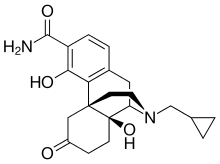Samidorphan
Samidorphan (INN, USAN) (developmental code names ALKS-33, RDC-0313), also known as 3-carboxamido-4-hydroxynaltrexone, is an opioid antagonist that preferentially acts as an antagonist of the μ-opioid receptor (MOR). It is under development by Alkermes for the treatment of major depressive disorder and possibly other psychiatric conditions.[2]
 | |
| Clinical data | |
|---|---|
| Other names | ALKS-33, RDC-0313; 3-Carboxamido-4-hydroxynaltrexone |
| Routes of administration | Oral |
| Pharmacokinetic data | |
| Elimination half-life | 7–9 hours[1] |
| Identifiers | |
IUPAC name
| |
| CAS Number | |
| PubChem CID | |
| ChemSpider | |
| UNII | |
| KEGG | |
| Chemical and physical data | |
| Formula | C21H26N2O4 |
| Molar mass | 370.441 g/mol g·mol−1 |
| 3D model (JSmol) | |
SMILES
| |
InChI
| |
Development
Samidorphan has been investigated for the treatment of alcoholism and cocaine addiction by its developer, Alkermes,[3][4] showing similar efficacy to naltrexone but possibly with reduced side effects.
However, it has attracted much more attention as part of the combination product ALKS-5461 (buprenorphine/samidorphan), where samidorphan is combined with the mixed MOR weak partial agonist and κ-opioid receptor (KOR) antagonist buprenorphine, as an antidepressant. Buprenorphine has shown antidepressant effects in some human studies, thought to be because of its antagonist effects at the KOR, but has not been further developed for this application because of its MOR agonist effects and consequent abuse potential. By combining buprenorphine with samidorphan to block the MOR agonist effects, the combination acts more like a selective KOR antagonist, and produces only antidepressant effects, without typical MOR effects such as euphoria or substance dependence being evident.[5][6]
Samidorphan is also being studied in combination with olanzapine, as ALKS-3831 (olanzapine/samidorphan), for use in schizophrenia.[7] It is hoped it will be effective while resulting in less weight gain. Phase II studies have begun.[8]
Pharmacology
Pharmacodynamics
The known activity profile of samidorphan at the opioid receptors is as follows:[9][10]
- μ-Opioid receptor (Ki = 0.052 nM; EC50 = N/A; Emax = 3.8%; IC50 = 0.88 nM; Imax = 92%)
- κ-Opioid receptor (Ki = 0.23 nM; EC50 = 3.3 nM; Emax = 36%; IC50 = 38 nM; Imax = 57%)
- δ-Opioid receptor (Ki = 2.6 nM; EC50 = 1.5 nM; Emax = 35%; IC50 = 6.9 nM; Imax = 56%)
As such, samidorphan is primarily an antagonist, or extremely weak partial agonist of the MOR.[9][10] In accordance with its in vitro profile, samidorphan has been observed to produce some side effects that are potentially consistent with activation of the KOR such as somnolence, sedation, dizziness, and hallucinations in some patients in clinical trials at the doses tested.[11]
See also
- Tianeptine, an atypical, selective MOR full-agonist licensed for major depression since 1989.
- 8-Carboxamidocyclazocine
- Cyprodime
- JDTic
References
- Single- and multiple-dose pharmacokinetics of samidorphan, a novel opioid antagonist, in healthy volunteers Clin Ther. 2015 Feb 1;37(2):338-48. doi: 10.1016/j.clinthera.2014.10.001. Epub 2014 Oct 29.
- http://adisinsight.springer.com/drugs/800029336
- Hillemacher, T.; Heberlein, A.; Muschler, M. A.; Bleich, S.; Frieling, H. (2011). "Opioid modulators for alcohol dependence". Expert Opinion on Investigational Drugs. 20 (8): 1073–1086. doi:10.1517/13543784.2011.592139. PMID 21651459.
- ALK33BUP-101: Safety and Pharmacodynamic Effects of ALKS 33-BUP Administered Alone and When Co-administered With Cocaine
- ALKS 5461 drug found to reduce depressive symptoms in Phase 1/2 study
- Investigational ALKS 5461 Channels ‘Opium Cure’ for Depression
- "Will Alkermes' Antipsychotic ALKS-3831 Become Another Tredaptive?". Forbes. Jan 15, 2013.
- "A Study of ALKS 3831 in Subjects With Schizophrenia and Alcohol Use Disorder".
- Linda P. Dwoskin (29 January 2014). Emerging Targets & Therapeutics in the Treatment of Psychostimulant Abuse. Elsevier Science. pp. 398–399, 402–403. ISBN 978-0-12-420177-4.
- Wentland, Mark P.; Lou, Rongliang; Lu, Qun; Bu, Yigong; Denhardt, Christoph; Jin, Jin; Ganorkar, Rakesh; VanAlstine, Melissa A.; Guo, Chengyun; Cohen, Dana J.; Bidlack, Jean M. (2009). "Syntheses of novel high affinity ligands for opioid receptors". Bioorganic & Medicinal Chemistry Letters. 19 (8): 2289–2294. doi:10.1016/j.bmcl.2009.02.078. ISSN 0960-894X. PMC 2791460. PMID 19282177.
- McElroy, Susan L.; Guerdjikova, Anna I.; Blom, Thomas J.; Crow, Scott J.; Memisoglu, Asli; Silverman, Bernard L.; Ehrich, Elliot W. (2013). "A placebo-controlled pilot study of the novel opioid receptor antagonist ALKS-33 in binge eating disorder". International Journal of Eating Disorders. 46 (3): 239–245. doi:10.1002/eat.22114. ISSN 0276-3478.
External links